Numerical and Experimental Investigation of the Effect of Traffic Load on the Mechanical Characteristics of HDPE Double-Wall Corrugated Pipe
Abstract
1. Introduction
2. Finite Element Formulations
2.1. Model of the HDPE Pipes
2.2. Dimensions of the Road Structure
2.3. Pipe Installation Procedure
2.4. Traffic Load Data
2.5. Simulated Conditions
3. Simulation Results and Sensitivity Analysis
3.1. General
3.2. Influence of Backfill Compaction on the Pipe During Installation
3.3. Influence of Buried Depth on the Pipe Under Traffic Load
3.4. Influence of Backfill Compactness on the Pipe Under Traffic Load
3.5. Influences of Traffic Loads on the Von-Mises Stress of the Pipe
3.6. Influences of Diameter on the Von-Mises Stress of the Pipe
3.7. Influences of Hoop Stiffness on the Von-Mises Stress of the Pipe
3.8. Influences of Backfill with Asymmetrical Compactness on the Pipe
4. Field Test
4.1. General
4.2. Description of HDPE Pipes and Strain Gauges
4.3. Installation and Traffic Load
4.4. Comparison of Test Results
5. Conclusions
- In the numerical simulation, the Von-Mises stress of the straight-walled pipe can be used to predict the deformation response of the interior wall of the corrugated pipe under an external load, and the method for simulating the real traffic load by combining the Vdload subroutine with the half sinusoid is credible.
- In the backfilling process, the maximum Von-Mises stress of the pipe is several times that of the stable state, the time during which the pipe is in this high-stress state is very short, and the influence on the pipe is very limited. The Von-Mises stress of the pipe is mainly determined by the earth’s pressure at the crown. The increase in the buried depth of the pipe increases the deformation of the pipe and reduces the influence of the traffic load on the pipe.
- Reducing the compaction degree of the backfill in contact with the pipe causes greater deformation of the pipe. Loose L1 has a negative effect on the pipe; the decrease in the compactness of L2 leads to an increase in the invert stress and a decrease in the stresses of the crown and the springline, and a decrease in the compactness of L3 results in an increase in stresses at the crown and the springline and decreases in the stress at the invert.
- Compared with the earth pressure, the impact of the traffic load on the pipe is very limited. Pipes are more sensitive to traffic loads when the compaction degree of the backfill in contact with the pipe decreases. The response of the Von-Mises stress of the pipe to traffic loads is determined by the magnitude and the speed of the load, and the maximum Von-Mises stress is proportional to the traffic load magnitude and independent of the load speed.
- The diameter and the hoop stiffness of the pipe affect the response of the pipe to the compactness of the backfill and the traffic load. The compactness of the backfill soil around the pipe needs to be higher when the diameter of the pipe is small; the variation in the hoop stiffness has a limited effect on the Von-Mises stress of the pipe, and there is no obvious law.
- If the compactness of the backfill on the left and right sides of the pipe is not consistent, then the Von-Mises stress concentrates near the region of the pipe in contact with the loose backfill. The Von-Mises stress fluctuation caused by the traffic load is more significant than the stress under standard conditions, but it can still be negligible.
Author Contributions
Funding
Acknowledgments
Conflicts of Interest
References
- Kang, J.S.; Han, T.H.; Kang, Y.J.; Yoo, C.H. Short-term and long-term behaviors of buried corrugated high-density polyethylene (HDPE) pipes. Compos. Part B: Eng. 2009, 40, 404–412. [Google Scholar] [CrossRef]
- Faragher, E.; Rogers, C.D.F.; Fleming, P.R. Laboratory determination of soil stiffness data for buried plastic pipes. Transp. Res. Rec. 1998, 1624, 231–236. [Google Scholar] [CrossRef]
- Rahman, F.; Hossain, M.; Hunt, M.; Romanoschi, S. Soil stiffness evaluation for compaction control of cohesionless embankments. Geotech. Test. J. 2008, 31, 442–451. [Google Scholar]
- Darabadi, B.K.; Khiavi, A.K.; Ouria, A.; Rasouli, R. Evaluation of the compactness of subbase and base geomaterials by using stiffness. Sādhanā 2018, 43, 195. [Google Scholar] [CrossRef]
- Park, H.M.; Chung, M.K.; Lee, Y.A.; Kim, B.I. A study on the correlation between soil properties and subgrade stiffness using the long-term pavement performance data. Int. J. Pavement Eng. 2013, 14, 146–153. [Google Scholar] [CrossRef]
- Vilhar, G.; Jovičić, V.; Coop, M.R. The role of particle breakage in the mechanics of a non-plastic silty sand. Soils Found. 2013, 53, 91–104. [Google Scholar] [CrossRef]
- Wang, Y.; Gao, Y.; Li, B.; Guo, L.; Cai, Y.; Mahfouz, A.H. Influence of initial state and intermediate principal stress on undrained behavior of soft clay during pure principal stress rotation. Acta Geotech. 2019, 14, 1379–1401. [Google Scholar] [CrossRef]
- Wang, Y.; Gao, Y.; Guo, L.; Yang, Z. Influence of intermediate principal stress and principal stress direction on drained behavior of natural soft clay. Int. J. Geomech. 2018, 18, 04017128. [Google Scholar] [CrossRef]
- Brachman, R.W.I.; Moore, I.D.; Munro, S.M. Compaction effects on strains within profiled thermoplastic pipes. Geosynt. Int. 2008, 15, 72–85. [Google Scholar] [CrossRef]
- Arockiasamy, M.; Chaallal, O.; Limpeteeprakarn, T. Full-scale field tests on flexible pipes under live load application. J. Perform. Constr. Fac. 2006, 20, 21–27. [Google Scholar] [CrossRef]
- Zhou, M. Mechanical Response of Buried HDPE Pipes Subjected to the Ground Subsidence. Ph.D. Thesis, Southeast University, Nanjing, China, July 2018. [Google Scholar]
- Masada, T.; Sargand, S.M. Peaking deflections of flexible pipe during initial backfilling process. J. Transp. Eng. 2007, 133, 105–111. [Google Scholar] [CrossRef]
- You, Q.; Zhang, Y.L.; Wang, F.; Du, Y.J.; Zhou, M. Full-scale field tests on hoop strains of buried HDPE pipes during construction. Chin. J. Geotech. Eng. 2014, 36, 2282–2290. [Google Scholar]
- Rogers, C.D.F.; Fleming, P.R.; Talby, R. Use of visual methods to investigate influence of installation procedure on pipe-soil interaction. Transport. Res. Rec. 1996, 1541, 76–85. [Google Scholar] [CrossRef]
- Talesnick, M.L.; Xia, H.W.; Moore, I.D. Earth pressure measurements on buried HDPE pipe. Geotechnique 2011, 61, 721–732. [Google Scholar] [CrossRef]
- Terzi, N.U.; Yılmazturk, F.; Yıldırım, S.; Kilic, H. Experimental Investigations of Backfill Conditions on the Performance of High-Density Polyethelene Pipes. Exp. Techniques 2012, 36, 40–49. [Google Scholar] [CrossRef]
- Dhar, A.S.; Moore, I.D.; McGrath, T.J. Two-dimensional analyses of thermoplastic culvert deformations and strains. J. Geotech. Geoenviron. 2004, 130, 199–208. [Google Scholar] [CrossRef]
- Al-Abri, D.S.; Mohamedzein, Y.E.-A. Performance of plastic pipes installed in dune sand. In Pipes 2010: Climbing New Peaks to Infrastructure Reliability: Renew, Rehab, and Reinvest, Proceedings of the Pipeline Division Specialty Conference, Keystone, CO, USA, 28 August–1 September 2010; Ruchti, G.F., Roode, T.J., Eds.; American Society of Civil Engineers: Reston, VA, USA, 2010; pp. 402–414. [Google Scholar]
- Naeini, S.A.; Mahmoudi, E.; Shojaedin, M.M.; Misaghian, M. Mechanical response of buried High-Density Polyethylene pipes under normal fault motions. KSCE J. Civ. Eng. 2016, 20, 2253–2261. [Google Scholar] [CrossRef]
- Zhai, K.; Fang, H.; Fu, B.; Wang, F.; Hu, B. Mechanical Response of Externally Bonded CFRP on Repair of PCCPs with Broken Wires under Internal Water Pressure. Constr. Build. Mater. 2020, 239, 117878. [Google Scholar] [CrossRef]
- Peindl, R.D.; Janardhanam, R.; Burns, F. Evaluation of flowable fly-ash backfill. I: Static loading. J. Geotech. Eng. 1992, 118, 449–463. [Google Scholar] [CrossRef]
- Hyodo, M.; Yasuhara, K. Analytical procedure for evaluating pore-water pressure and deformation of saturated clay ground subjected to traffic loads. In Numerical Methods in Geomechanics Volume 1, Proceedings of the 6th International Conference on Numerical Methods in Geomechanics, Innsbruck, Austria, 11–15 April 1988; Swoboda, G., Ed.; Routledge: Abingdon, UK, 2017; pp. 653–658. [Google Scholar]
- Cebon, D. Interaction between Heavy Vehicles and Roads, 1st ed.; Society of Automotive Engineers: Warrendale, PA, USA, 1993. [Google Scholar]
- Noor, M.A.; Dhar, A.S. Three-dimensional response of buried pipe under vehicle loads. In New Pipe Technologies, Security, and Safety, Proceedings of the ASCE International Conference on Pipeline Engineering and Construction, Baltimore, MD, USA, 13–16 July 2003; Najafi, M., Ed.; American Society of Civil Engineers: Reston, VA, USA, 2003; pp. 658–665. [Google Scholar]
- Li, B.; Fang, H.; He, H.; Yang, K.; Chen, C.; Wang, F. Numerical simulation and full-scale test on dynamic response of corroded concrete pipelines under Multi-field coupling. Constr. Build. Mater. 2019, 200, 368–386. [Google Scholar] [CrossRef]
- Li, B.; Fang, H.; Yang, K.; Tan, P.; Wang, F. Dynamic analysis of concrete pipes under the coupled effects of traffic load and groundwater level fluctuations. Energy Sci. Eng. 2020, 8, 203–215. [Google Scholar] [CrossRef]
- Li, B.; Fang, H.; Yang, K.; He, H.; Tan, P.; Wang, F. Mechanical Response and Parametric Sensitivity Analyses of a Drainage Pipe under Multiphysical Coupling Conditions. Complexity 2019, 2019, 3635621. [Google Scholar] [CrossRef]
- Mohamedzein, Y.E.-A.; Al-Aghbari, M.Y. Experimental study of the performance of plastic pipes buried in dune sand. Int. J. Geotech. Eng. 2016, 10, 236–245. [Google Scholar] [CrossRef]
- Zhan, C.; Rajani, B. Load transfer analyses of buried pipe in different backfills. J. Transp. Eng. 1997, 123, 447–453. [Google Scholar] [CrossRef]
- Dhar, A.S.; Moore, I.D. Liner buckling in profiled polyethylene pipes. Geosynth. Int. 2001, 8, 303–326. [Google Scholar] [CrossRef]
- Zhou, M.; Du, Y.J.; Zhang, Y.J.; Fei, W.; Qin, X.G. Study on Variation Characteristics of Soil Arch Effect during Construction of Buried HDPE Pipe. J. Rock Mech. Eng. 2015, 34, 414–424. [Google Scholar]
- You, Q.; Zhang, Y.J.; Fei, W.; Du, Y.J.; Zhou, M. Field Test Research on Distribution Law of Assembly Strain in Construction Process of Buried HDPE Pipe. J. Geotech. Eng. 2014, 36, 2282–2290. [Google Scholar]
- Zhou, M.; Du, Y.J.; Wang, F.; Arulrajah, A.; Horpibulsuk, S. Earth pressures on the trenched HDPE pipes in fine-grained soils during construction phase: Full-scale field trial and finite element modeling. Transp. Geotech. 2017, 12, 56–69. [Google Scholar] [CrossRef]
- Wang, F.; Du, Y.J.; Zhou, M.; Zhang, Y.J. Experimental study of the effects produced by a backfilling process on full-scale buried corrugated HDPE pipes in fine-grained soils. J. Pipe Syst. Eng. Pract. 2015, 7, 05015001. [Google Scholar] [CrossRef]
- Zhang, J.; Xie, R.; Zhang, H. Mechanical response analysis of the buried pipe due to adjacent foundation pit excavation. Tunn. Undergr. Sp. Tech. 2018, 78, 135–145. [Google Scholar] [CrossRef]
- Ministry of Housing and Urban-Rural Development and General Administration of Supervision. CJJ143-2010 Technical Specification for Buried Plastic Drainage Pipe Engineering[s]; China Architecture & Building Press: Beijing, China, 2010. [Google Scholar]
- Fang, H.; Li, B.; Wang, F.; Wang, Y.; Cui, C. The mechanical behaviour of drainage pipe under traffic load before and after polymer grouting trenchless repairing. Tunn. Undergr. Sp. Tech. 2018, 74, 185–194. [Google Scholar] [CrossRef]
- Moradi, G.; Abbasnejad, A. Experimental and numerical investigation of arching effect in sand using modified Mohr Coulomb. Geomech. Eng. 2015, 8, 829–844. [Google Scholar] [CrossRef]
- Kaya, E.S.; Uckan, E.; Cakir, F.; Akbas, B. A 3D nonlinear numerical analysis of buried steel pipes at strike-slip fault crossings. Gradevinar 2016, 68, 815–823. [Google Scholar]
- Dadfar, B.; El Naggar, M.H.; Nastev, M. Ovalization of steel energy pipes buried in saturated sands during ground deformations. Comput. Geotech. 2015, 69, 105–113. [Google Scholar] [CrossRef]
- Taleb, B.; Moore, I.D. Metal culvert response to earth loading: Performance of two-dimensional analysis. Transport. Res. Rec. 1999, 1656, 25–36. [Google Scholar] [CrossRef]
- McGrath, T.J.; Selig, E.T.; Webb, M.C.; Zoladz, G.V. Pipe Interaction with the Backfill Envelope; FHWA-RD-98-191; National Science Foundation: Washington, DC, USA, 1999.
- Elshimi, T.M.; Moore, I.D. Modeling the effects of backfilling and soil compaction beside shallow buried pipes. J. Pipe Syst. Eng. Pract. 2013, 4, 04013004. [Google Scholar] [CrossRef]
- Li, H.Y. Research on the Dynamics of Pavement Structure due to Vehicle and Pavement Interaction; Beijing Jiaotong University: Beijing, China, July 2011. [Google Scholar]
- Lv, P.M.; Dong, Z.H. Mechanical analysis of vehicle-asphalt pavement system. Rock Soil Mech. 2010, 2010, 2950. [Google Scholar]
- Zhao, Y.Q.; Zhou, C.H.; Wang, G.Z.; Wang, Z.C. Analysis of viscoelastic response of asphalt pavement under pulse loading. J. Dalian Univ. Technol. 2011, 51, 73–77. [Google Scholar]
- Wu, X.G. Study on the Mechanical Analysis Model of Pipes in Soft Ground Under Traffic Loads. Ph.D. Thesis, Zhejiang University, Zhejiang, China, July 2004. [Google Scholar]
- Huang, Y.H. Pavement Analysis and Design; China Communications Publishing: Beijing, China, 1998. [Google Scholar]
- Ministry of Housing and Urban-Rural Development and General Administration of Supervision. Structural Design Code of Pipes of Water Supply and Waste Water Engineering[s]; China Planning Press: Beijing, China, 2011. [Google Scholar]
- Zhang, C.; Moore, I.D. Nonlinear mechanical response of high-density polyethylene. Part I: Experimental investigation and model evaluation. Polym. Eng. Sci. 1997, 37, 404–413. [Google Scholar] [CrossRef]
- Tafreshi, S.N.M.; Khalaj, O. Analysis of repeated-load laboratory tests on buried plastic pipes in sand. Soil Dyn. Earthq. Eng. 2011, 31, 1–15. [Google Scholar] [CrossRef]
- Khademi-Zahedi, R.; Alimouri, P. Finite Element Analysis to the Effect of Thermo-Mechanical Loads on Stress Distribution in Buried Polyethylene Gas Pipes Jointed by Electrofusion Sockets, Repaired by PE Patches. Energies 2018, 11, 2818. [Google Scholar] [CrossRef]
- Zhang, J.; Liang, Z.; Han, C. Effect of surrounding soil on stress–strain response of buried pipes underground loads. IES J. A: Civ. Struct. Eng. 2015, 8, 197–203. [Google Scholar]
- Liu, X.; Zhang, H.; Xia, M.; Chen, Y.; Wu, K.; Wang, B. Numerical Analysis and Strength Evaluation of an Exposed River Crossing Pipe with Casing Under Flood Load. Period. Polytech. Civ. Eng. 2018, 62, 911–920. [Google Scholar]
- Howard, A.; Spridzans, J.B.; Schrock, B.J. Latvia field test of 915-mm fiberglass pipe. In Buried Plastic Pipe Technology: 2nd Volume; Eckstein, D., Ed.; ASTM International: West Conshohocken, PA, USA, 1994; pp. 3–21. [Google Scholar]
- Fleming, P.R.; Faragher, E.; Rogers, C.D.F. Laboratory and field testing of large-diameter plastic pipe. Transport. Res. Rec. 1997, 1594, 208–216. [Google Scholar] [CrossRef]
- Sonoda, Y.; Kawabata, T.; Asao, H.; Morikami, H.; Ling, H.I. The Influence of Non-Uniform Bedding on the Mechanical Behavior of Buried Flexible Pipe. In Pipes 2013: Pipes and Trenchless Construction and Renewals—A Global Perspective, Proceedings of the Pipelines 2013 Conference, Forth Worth, TX, USA, 23–26 June 2013; Arnaut, S., Slavin, L., Eds.; American Society of Civil Engineers: Reston, VA, USA, 2013; pp. 1320–1328. [Google Scholar]
- McGrath, T.J.; DelloRusso, S.J.; Boynton, J. Performance of thermoplastic culvert pipe under highway vehicle loading. In Pipes 2002: Beneath Our Feet: Challenges and Solutions, Proceedings of the ASCE Pipeline Division Speciality Conference, Cleveland, OH, USA, 4–7 August 2002; Kurz, G.E., Ed.; American Society of Civil Engineers: Reston, VA, USA, 2002; pp. 1–14. [Google Scholar]
- Diogo, A.F.; Barros, L.T.; Santos, J.; Temido, J.S. An effective and comprehensive model for optimal rehabilitation of separate sanitary sewer systems. Sci. Total Environ. 2018, 612, 1042–1057. [Google Scholar] [CrossRef] [PubMed]
- Alzabeebee, S.; Chapman, D.N.; Faramarzi, A. Innovative approach to determine the minimum wall thickness of flexible buried pipes. Geomech. Eng. 2018, 15, 755–767. [Google Scholar]
- Trickey, S.A.; Moore, I.D.; Balkaya, M. Parametric study of frost-induced bending moments in buried cast iron water pipes. Tunn. Undergr. Spac. Tech. 2016, 51, 291–300. [Google Scholar] [CrossRef]
- Cholewa, J.A.; Brachman, R.W.I.; Moore, I.D. Axial stress-strain response of HDPE from whole pipes and coupons. J. Mater. Civil Eng. 2011, 23, 1377–1386. [Google Scholar] [CrossRef]
- Ministry of Housing and Urban-Rural Development and General Administration of Supervision. GB50268-2008 Code for Construction and Acceptance of Water and Sewerage Pipe Works [s]; China Architecture & Building Press: Beijing, China, 2008. [Google Scholar]
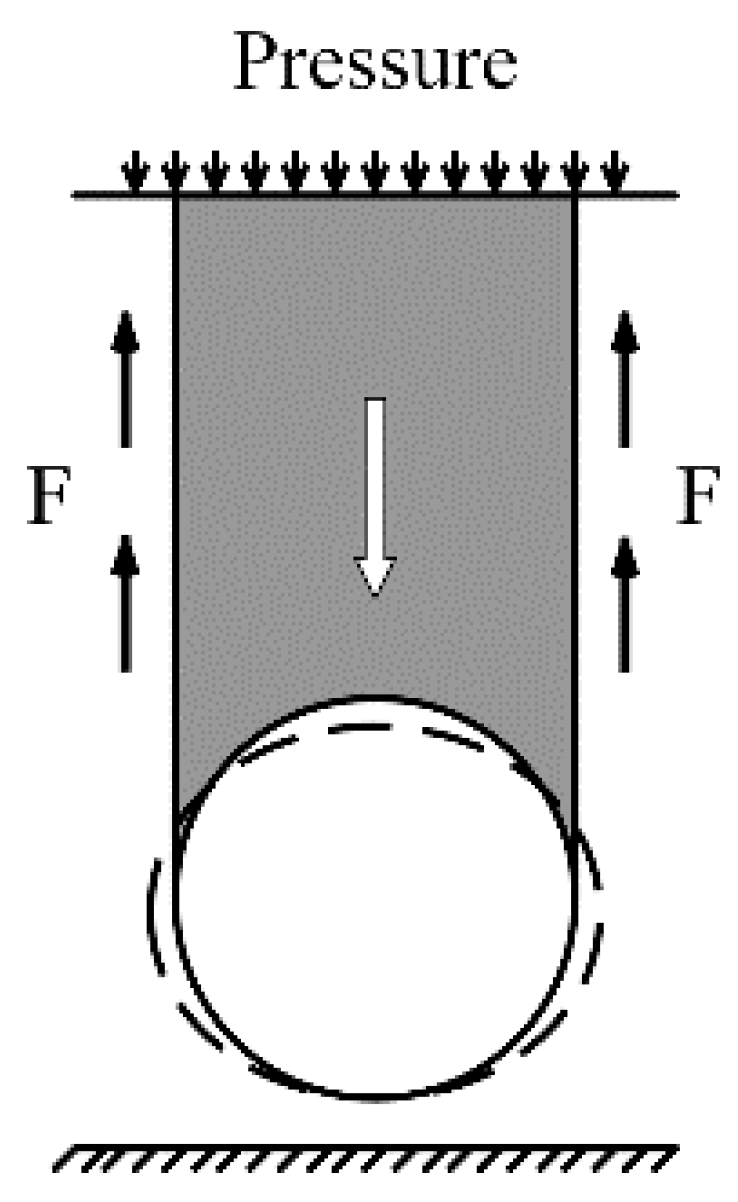
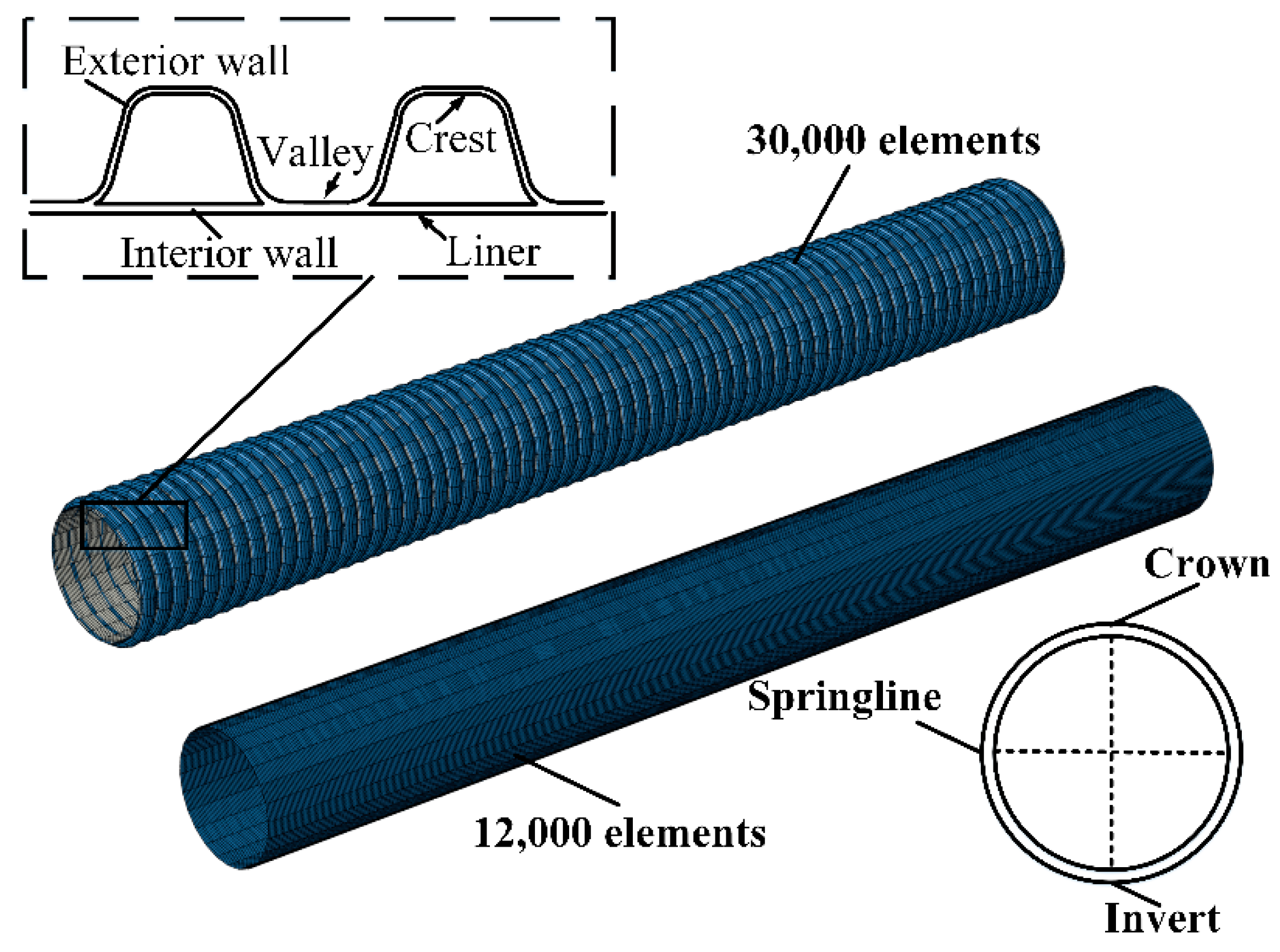
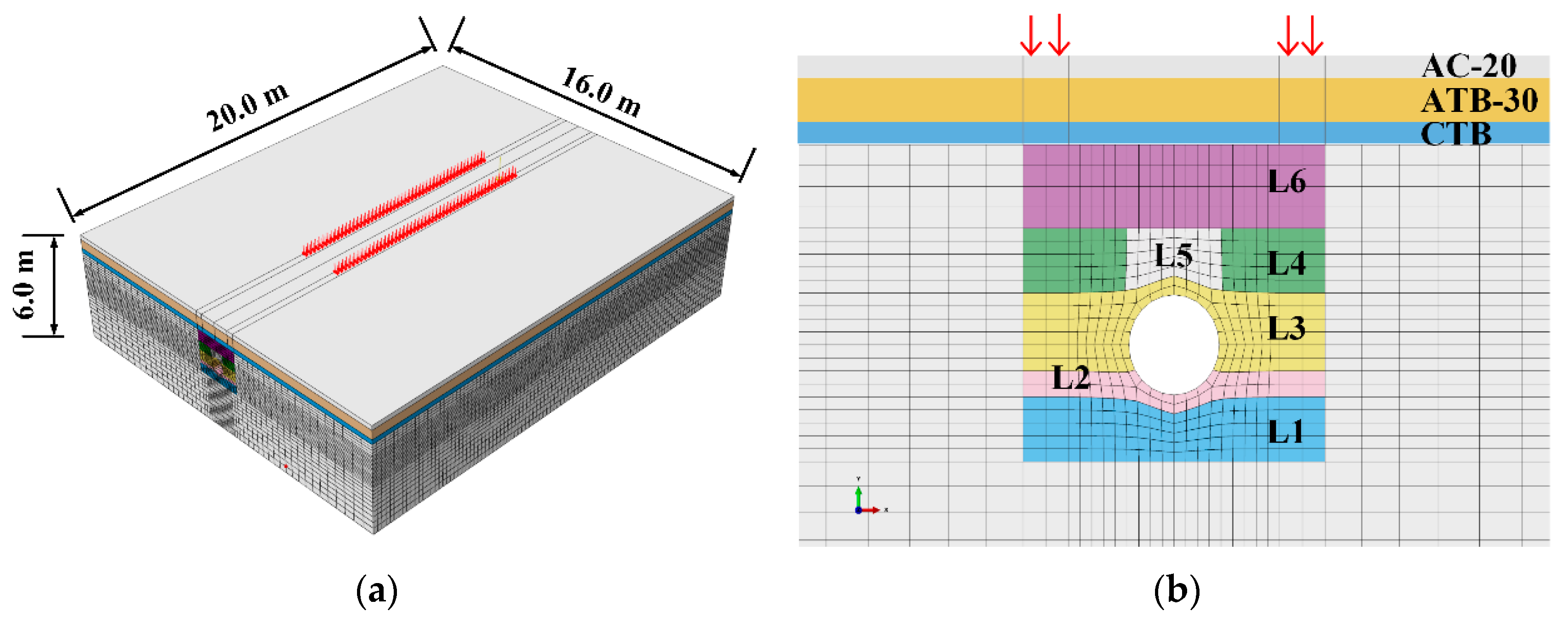

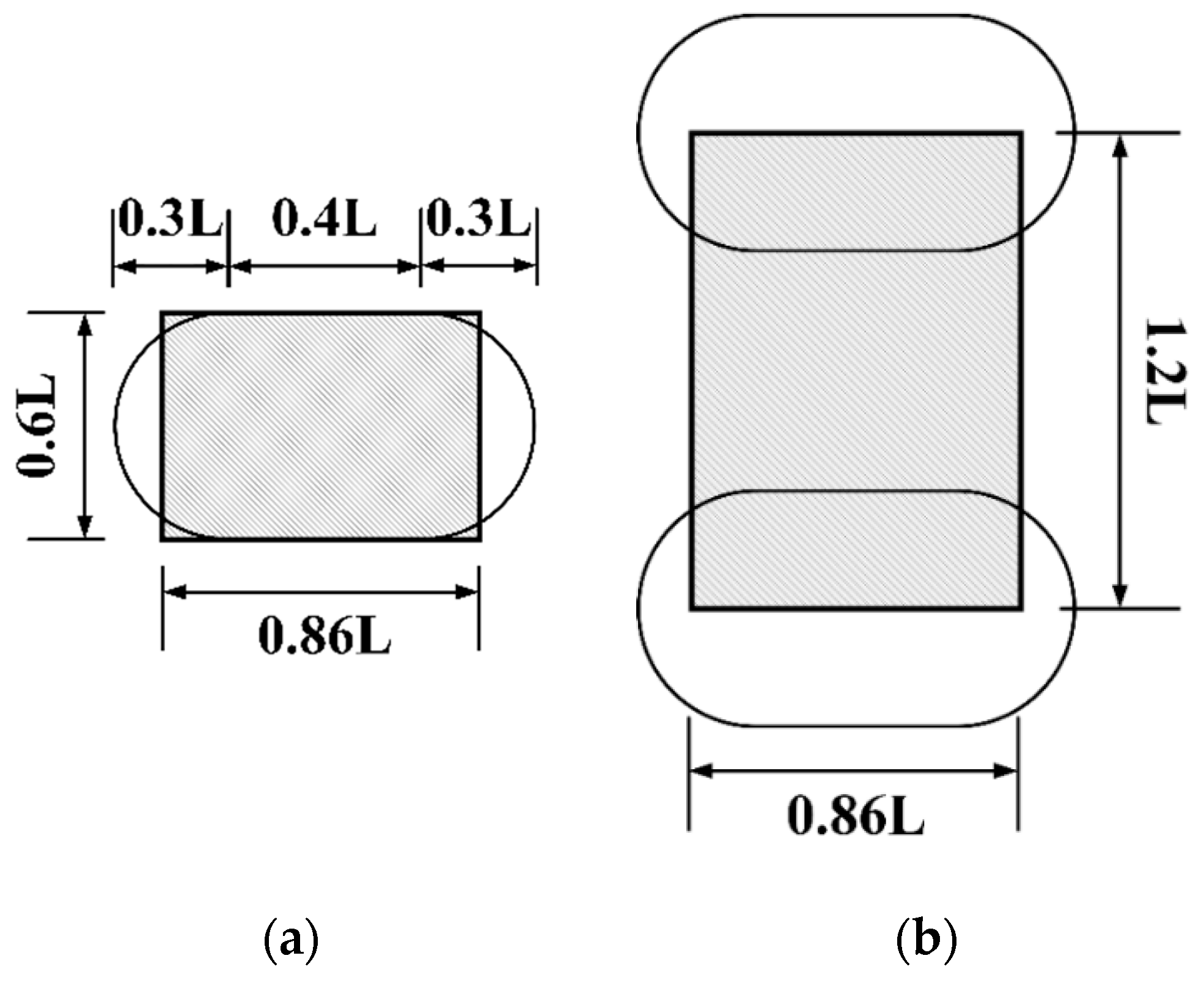
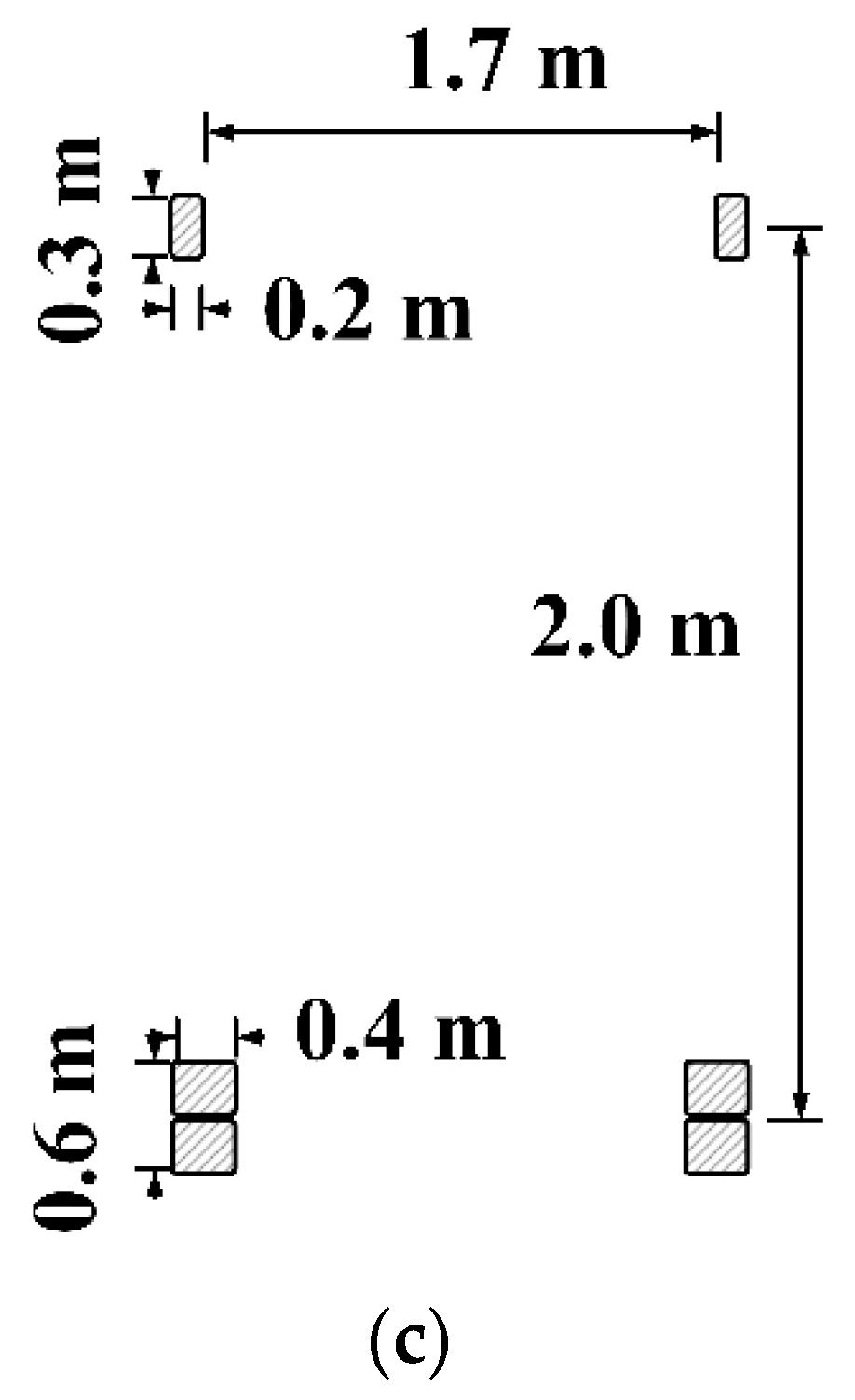
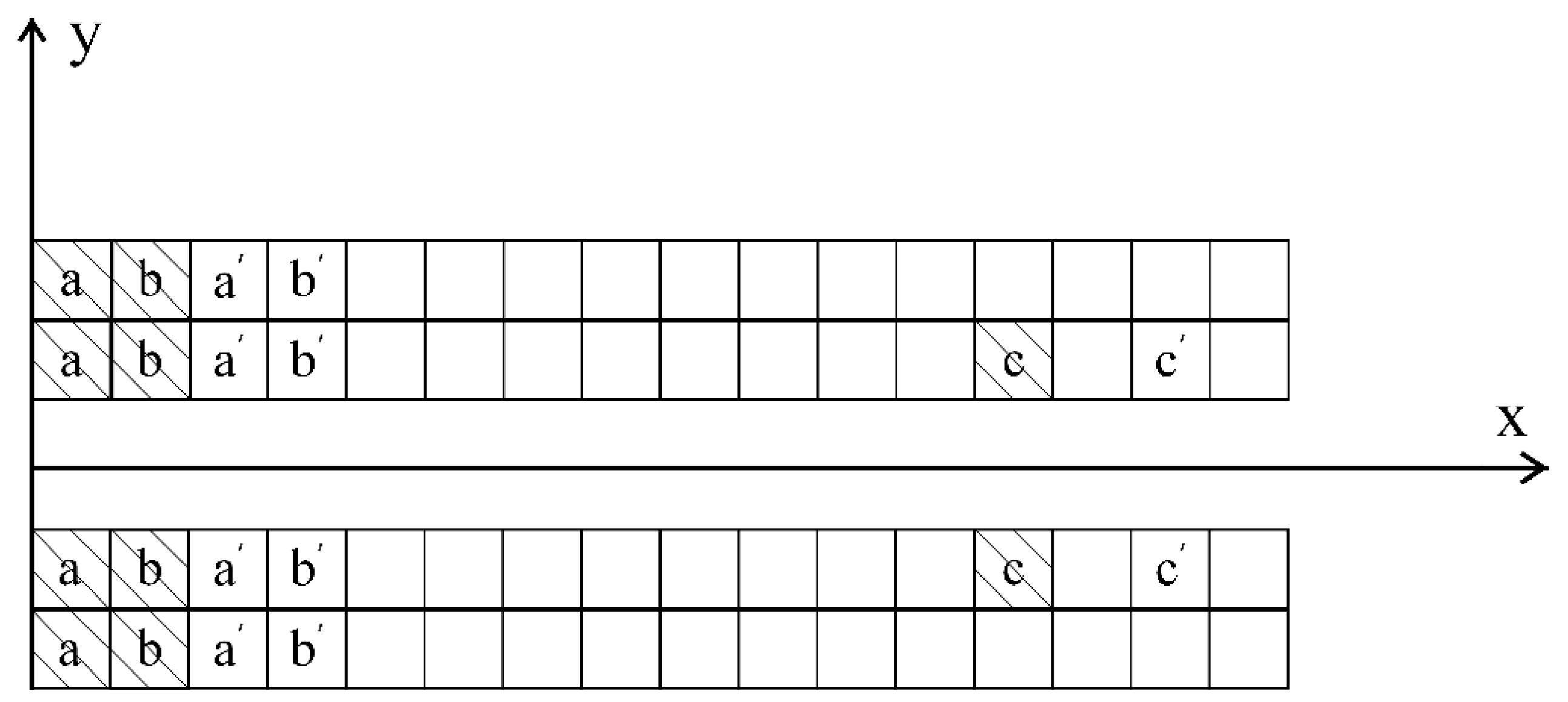
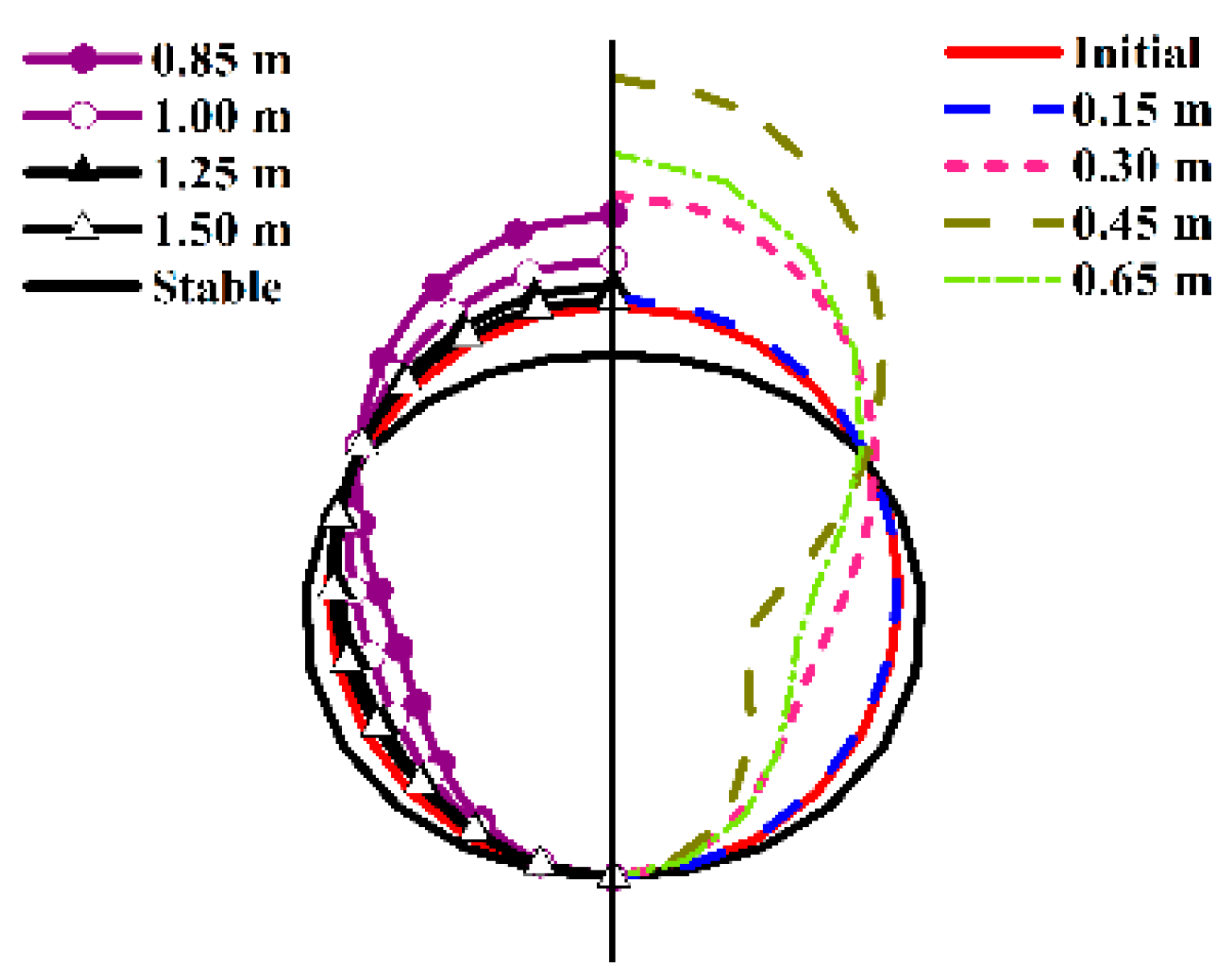
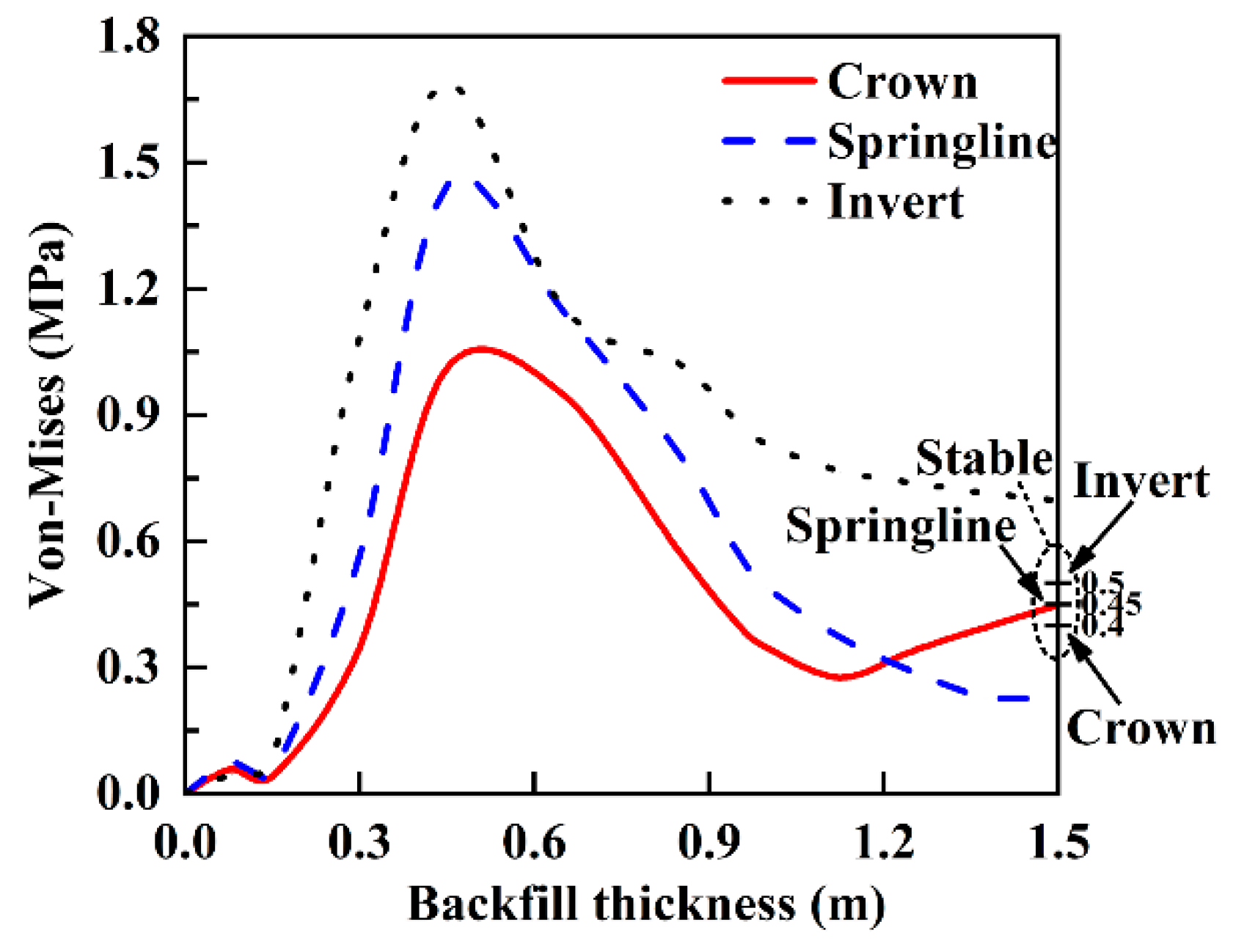


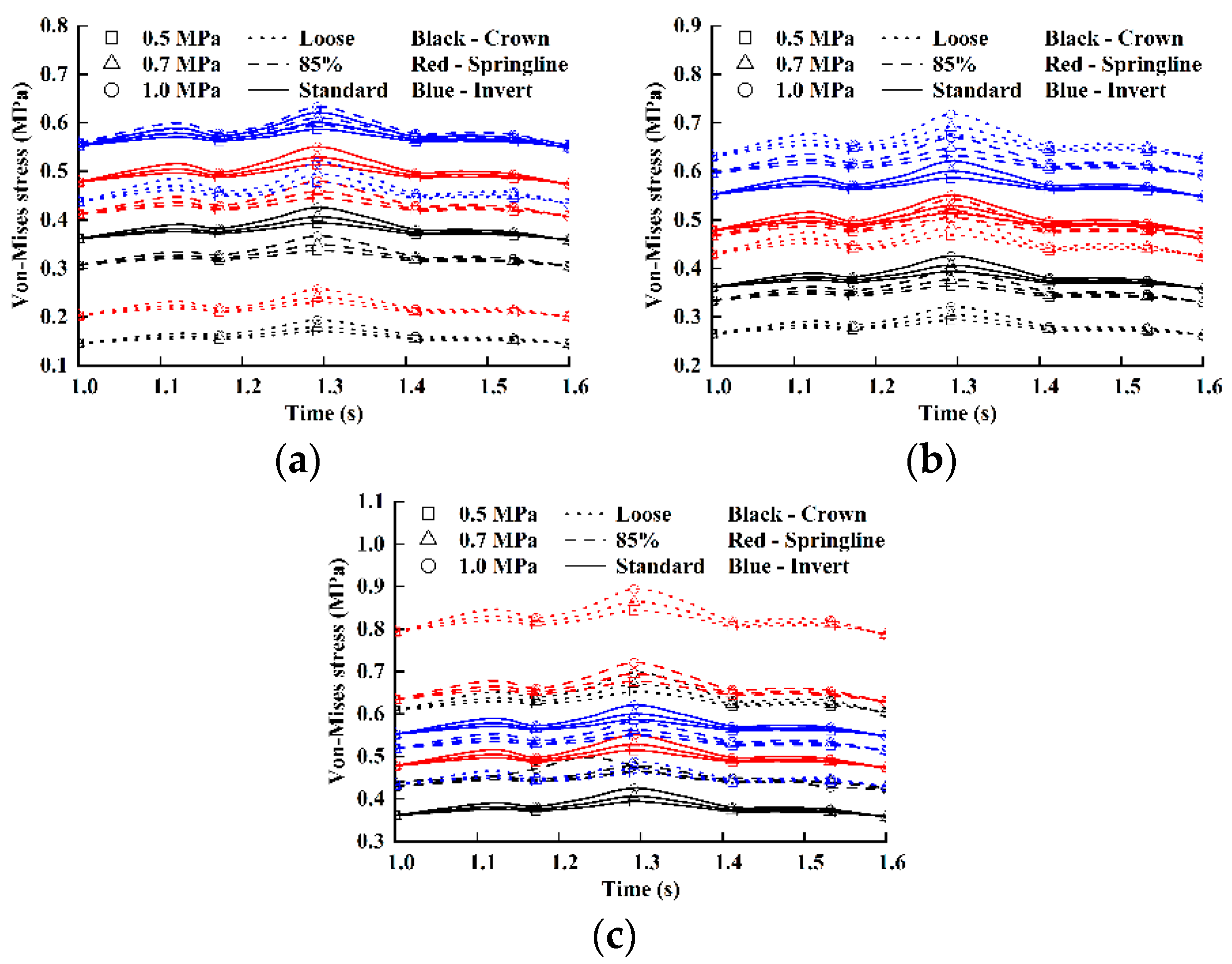
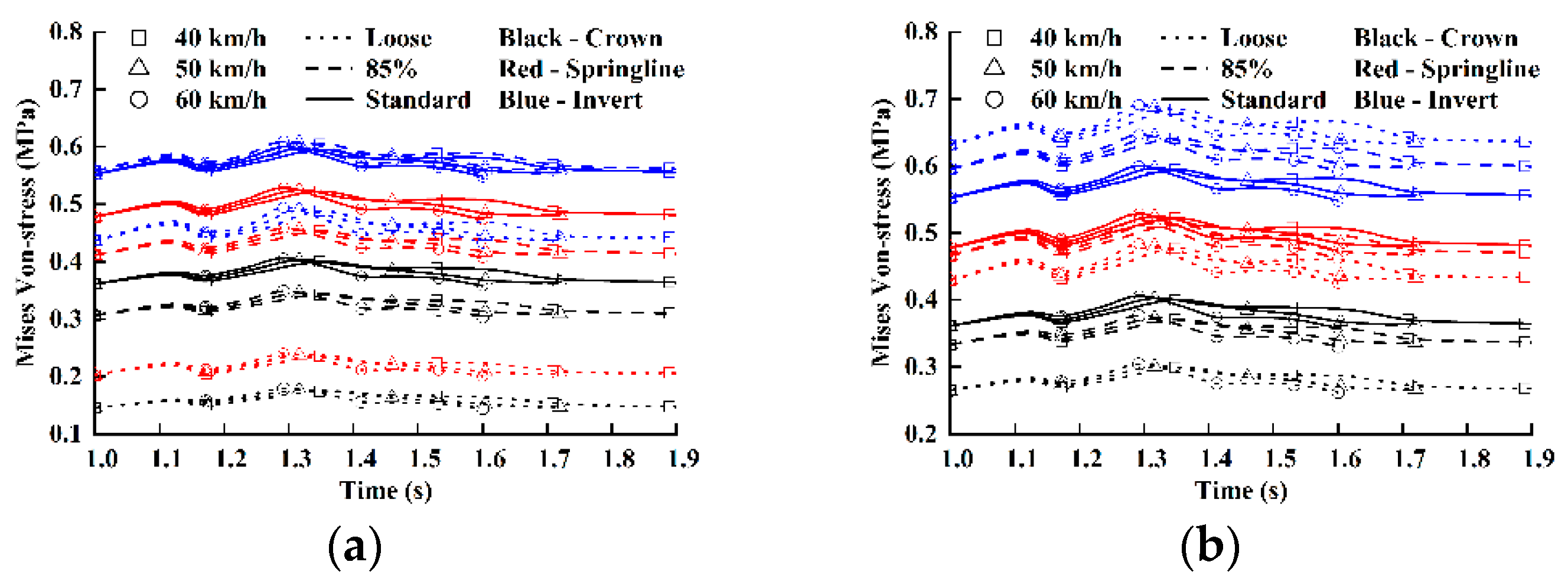
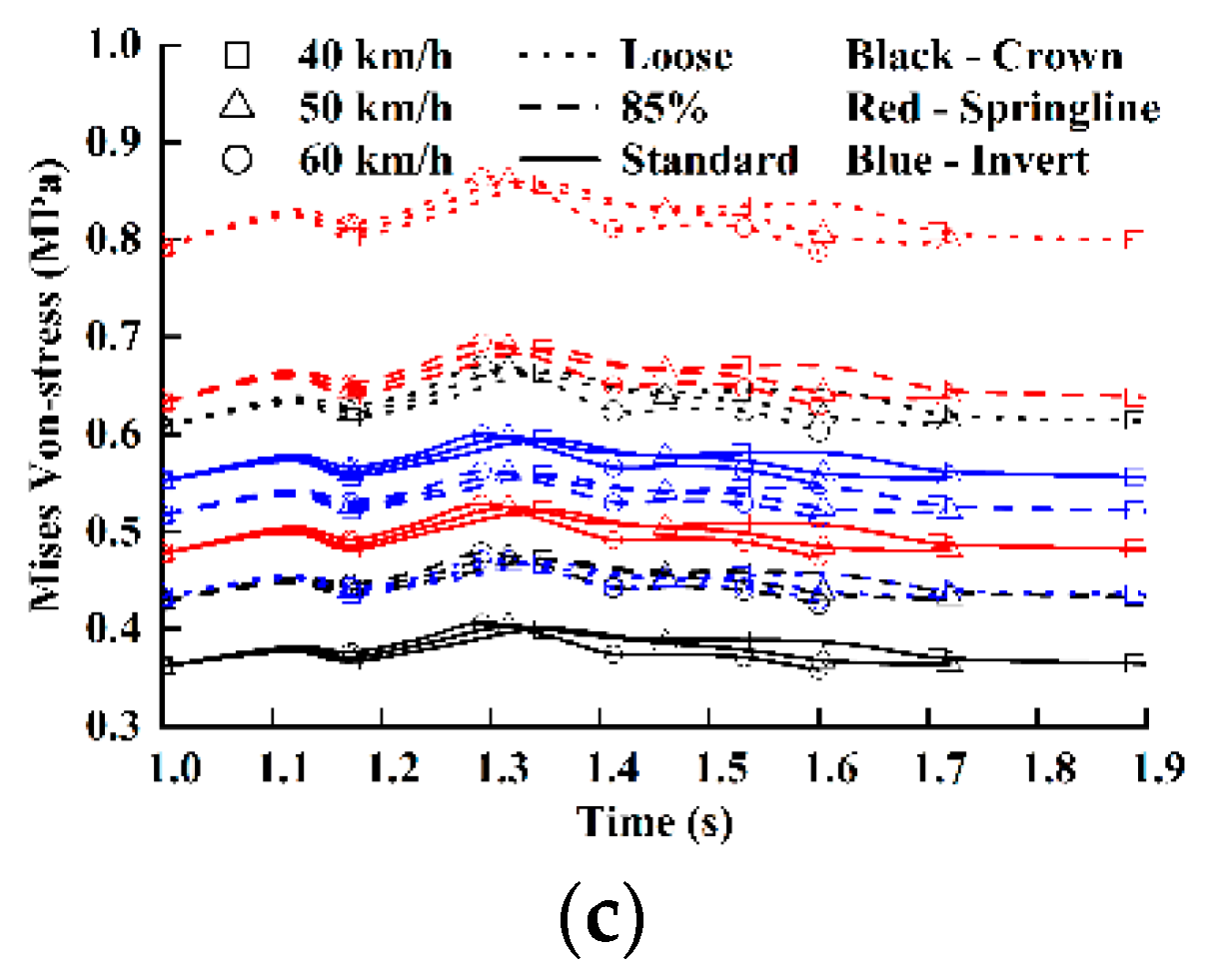
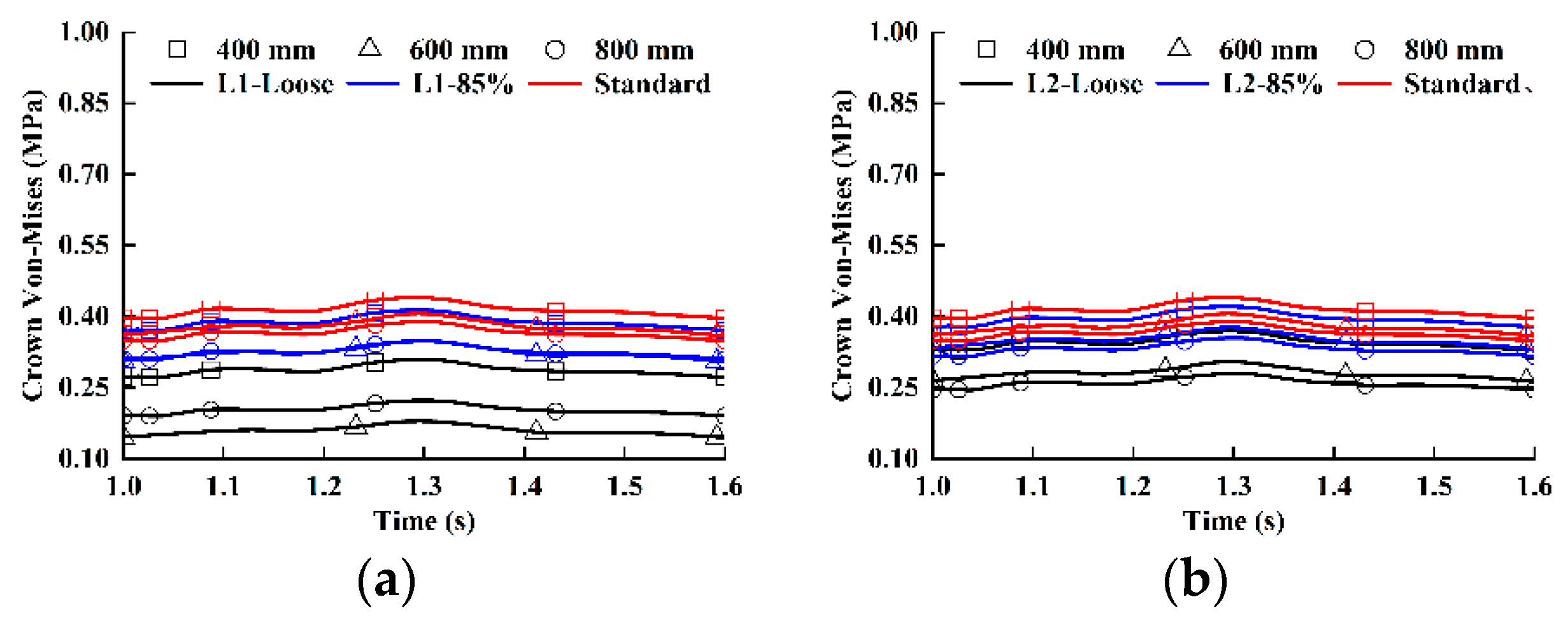


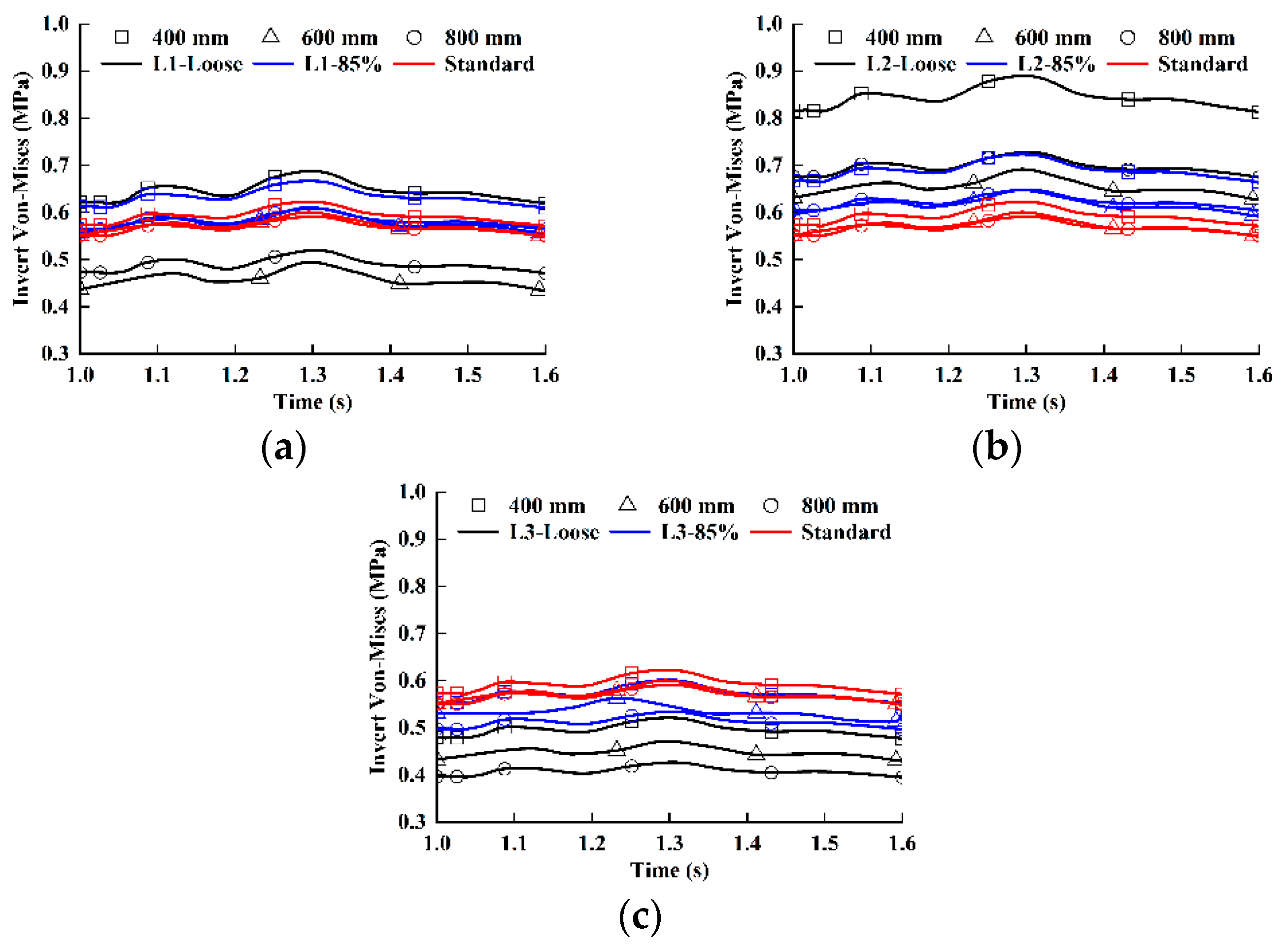
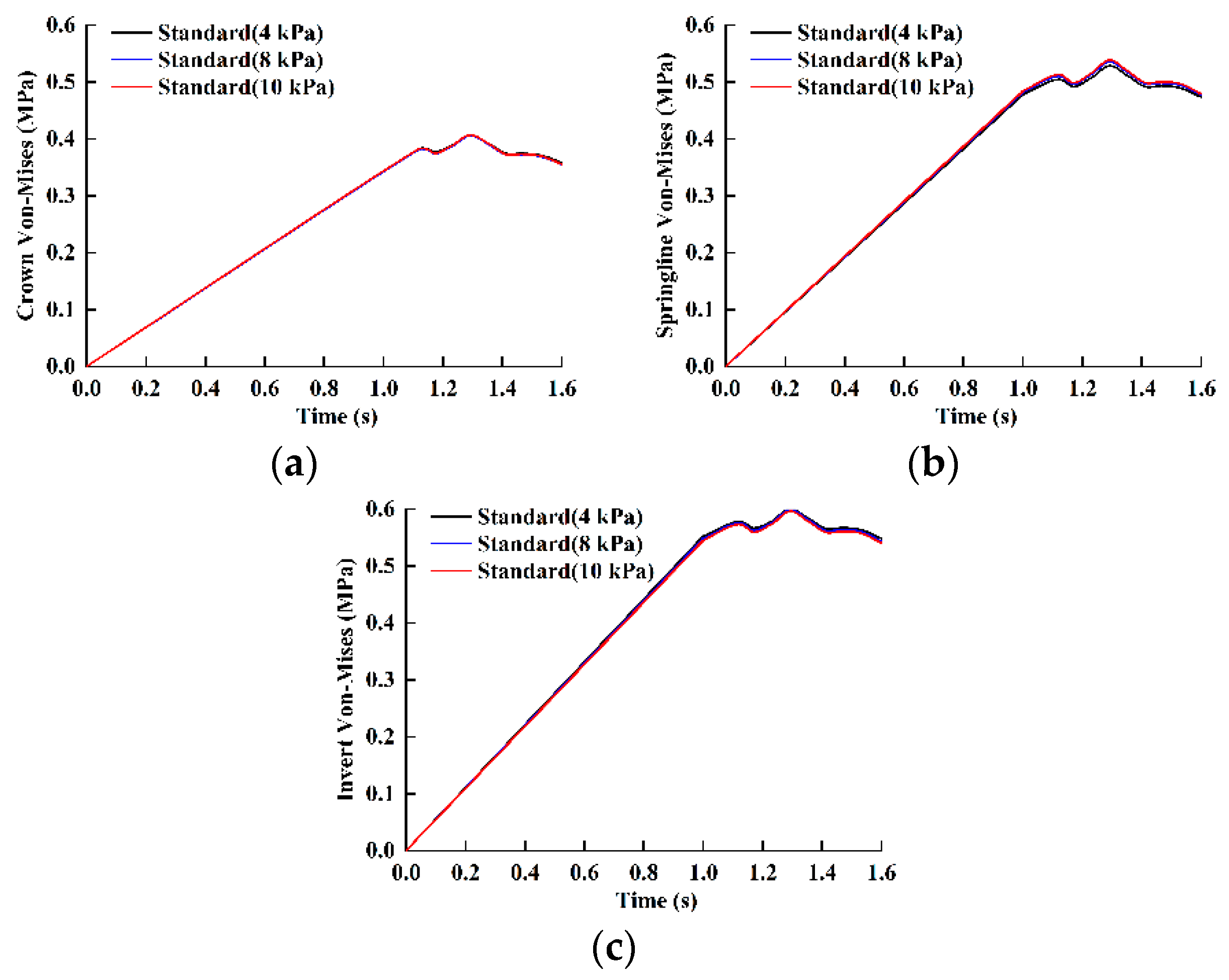
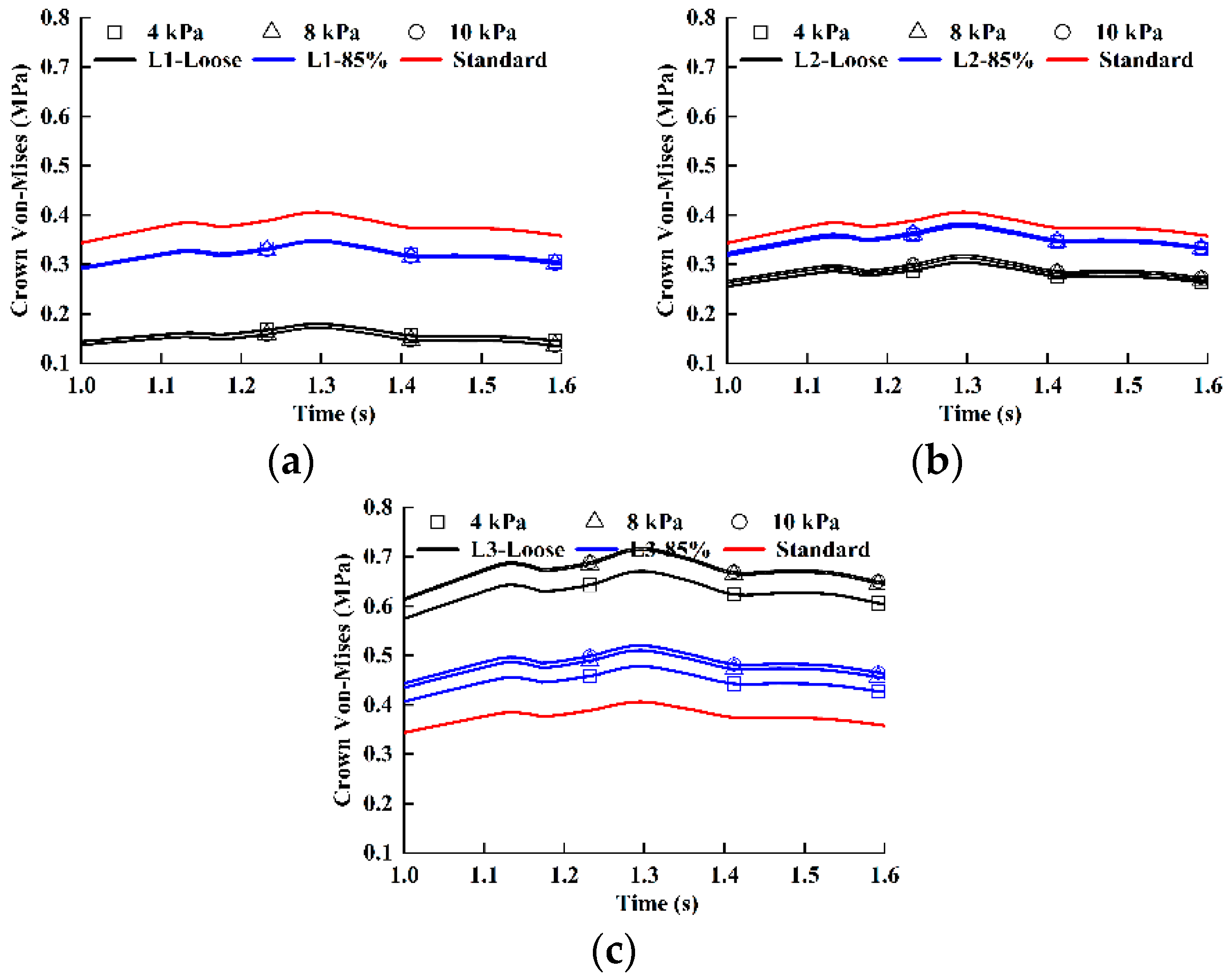
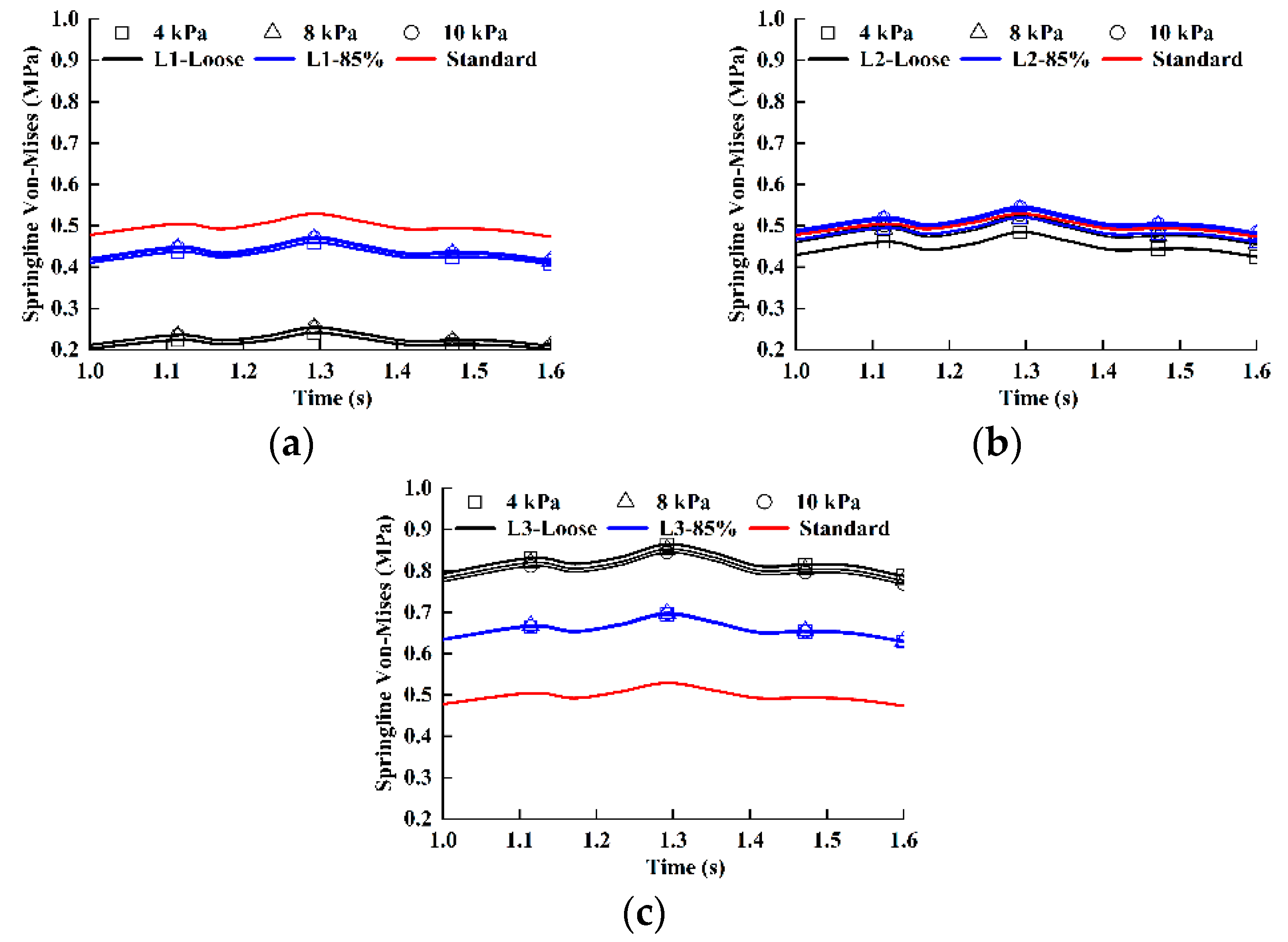
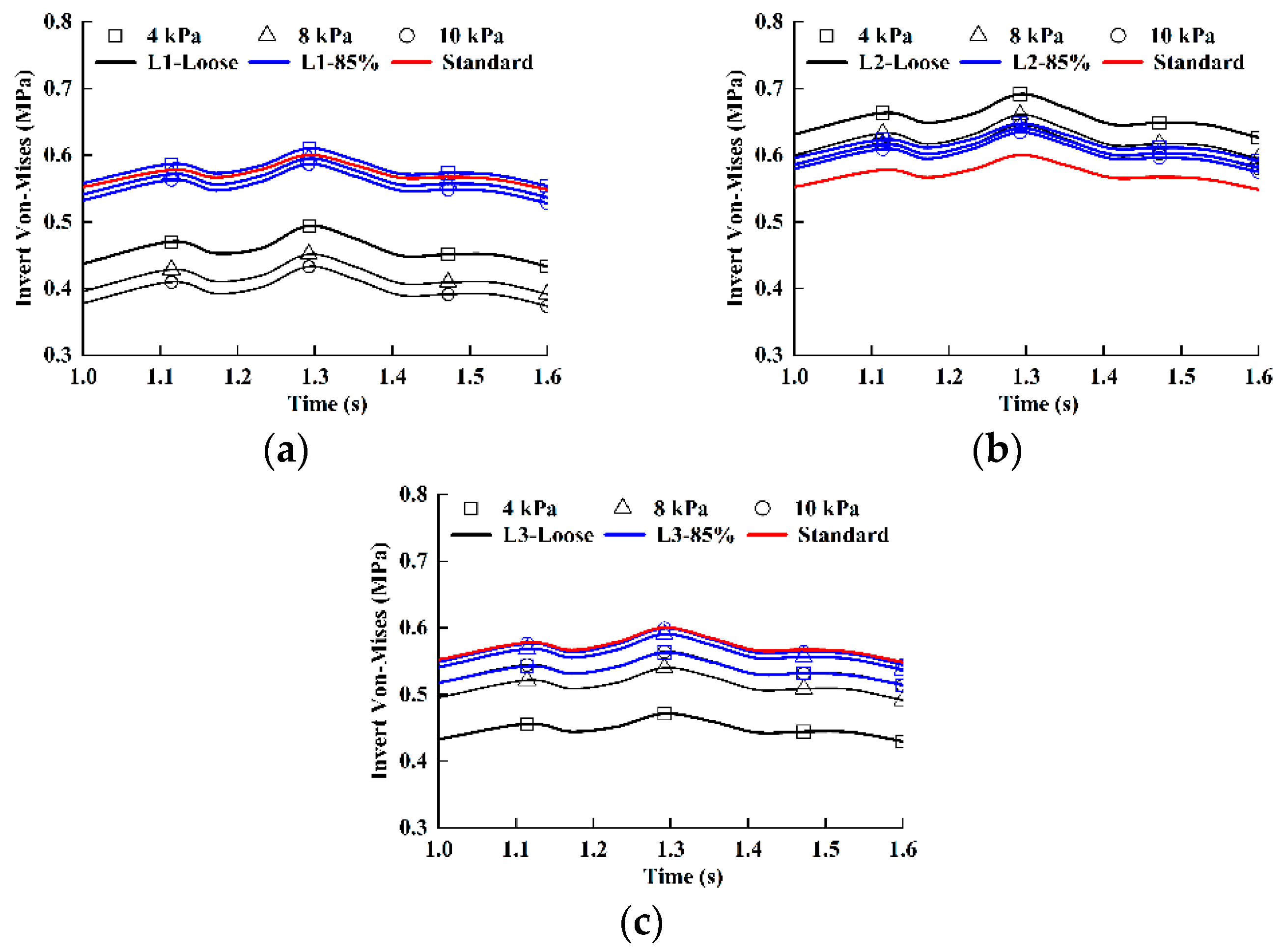
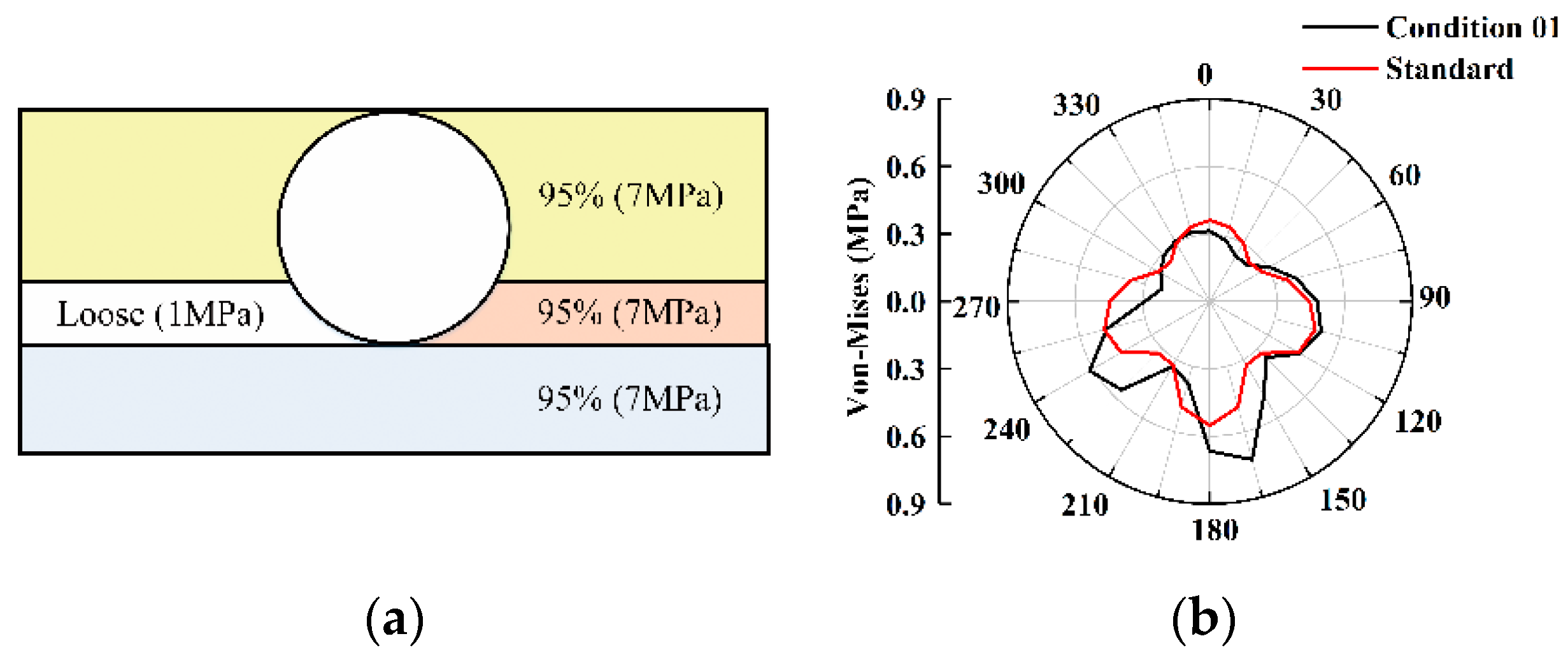
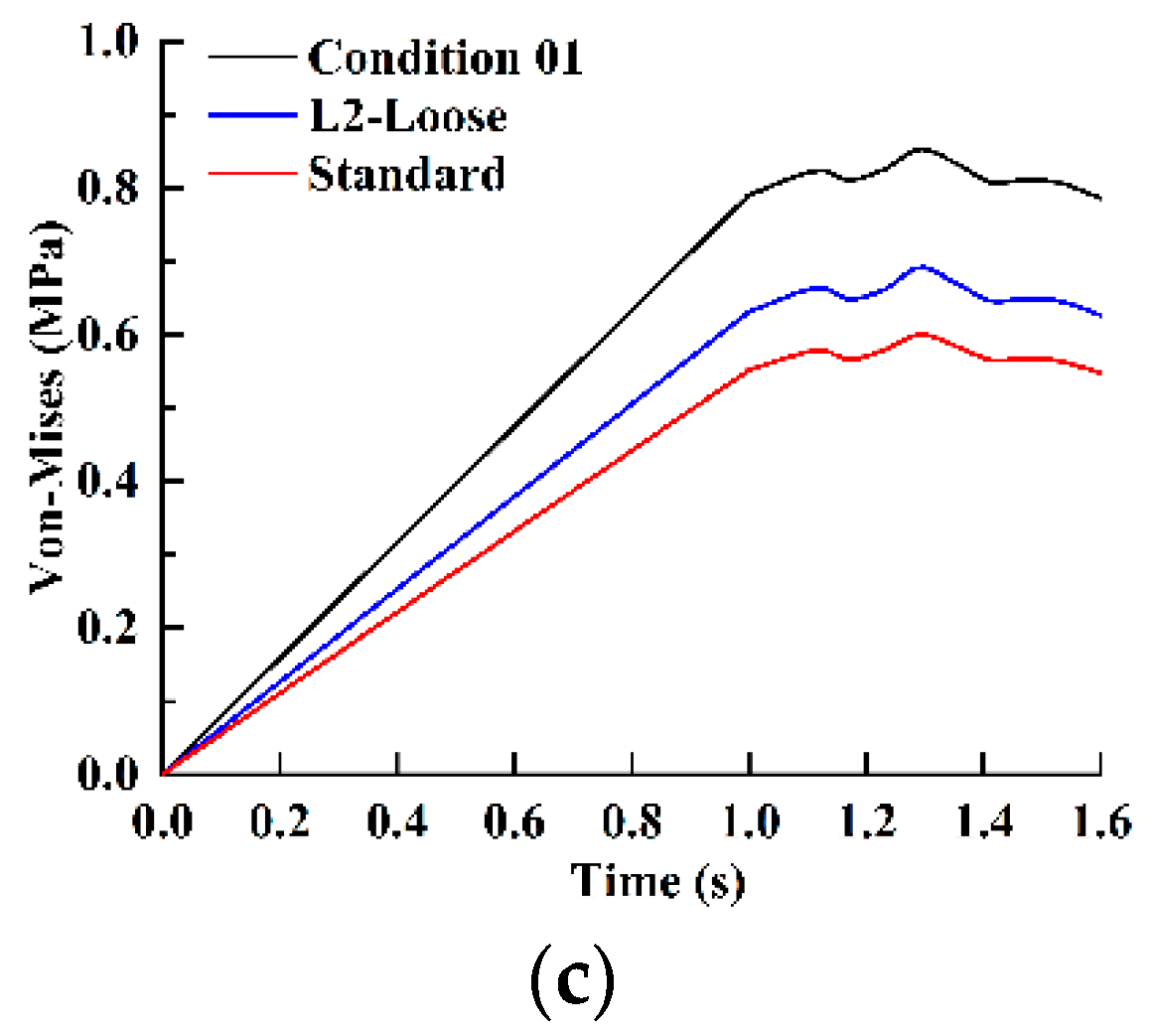
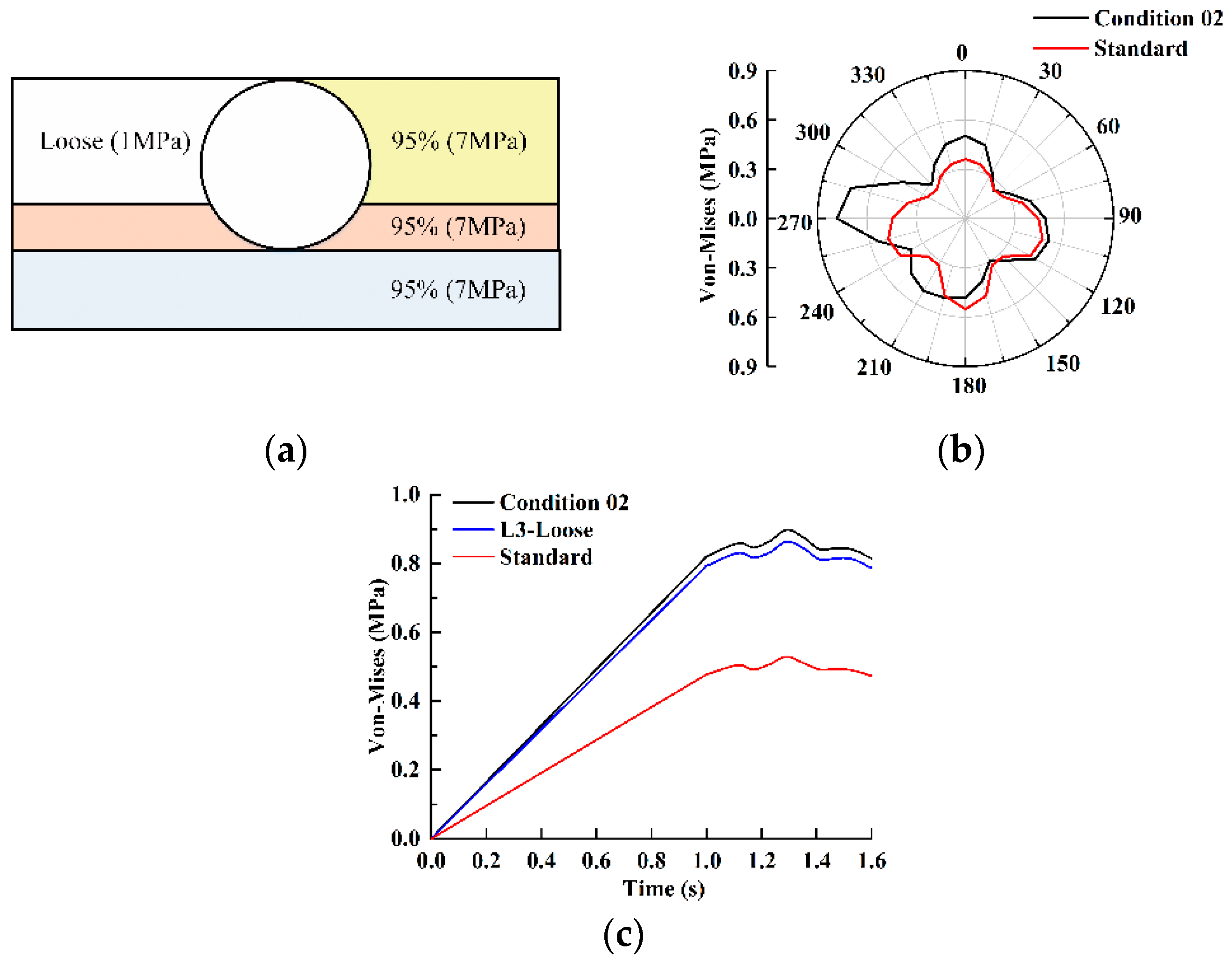
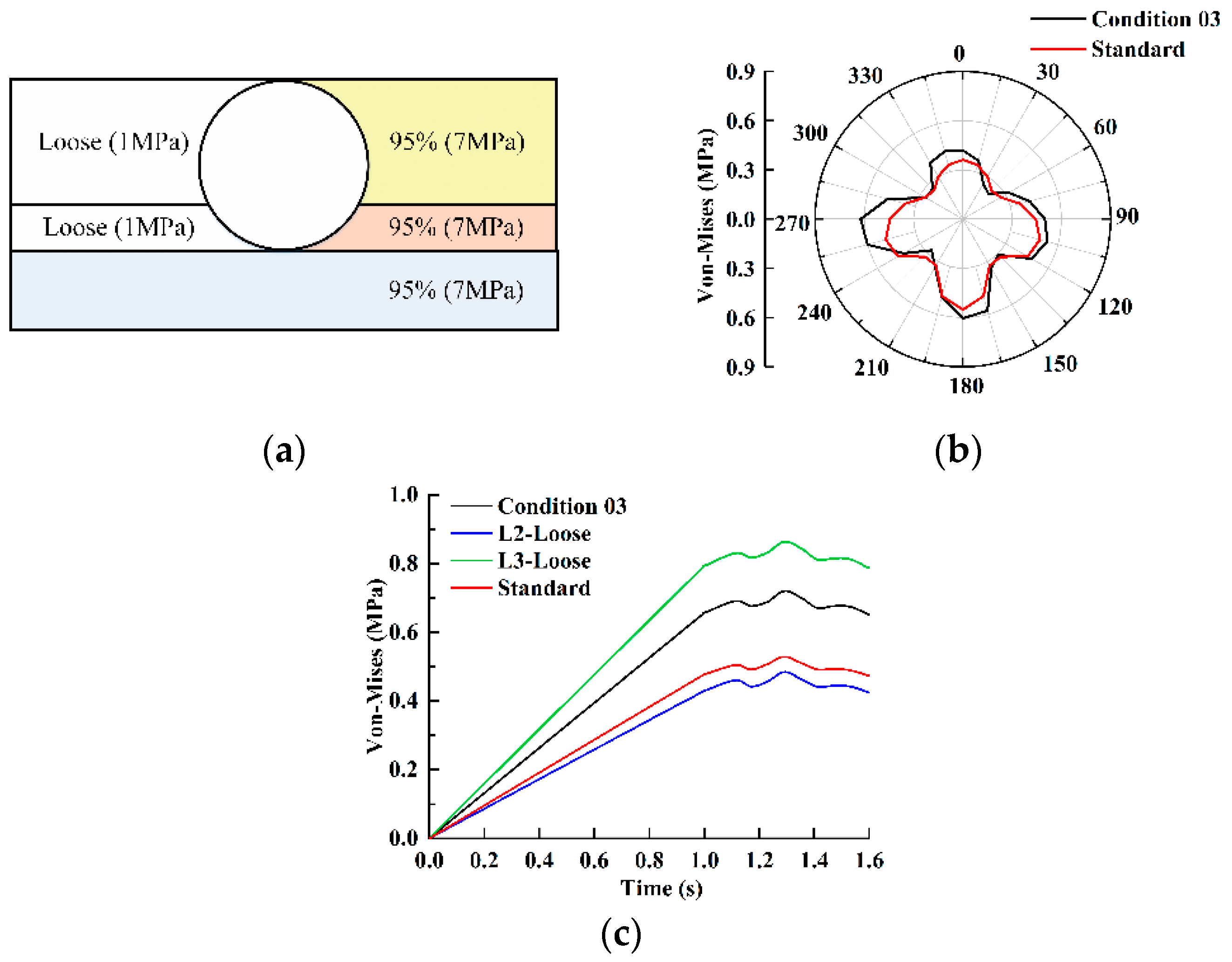

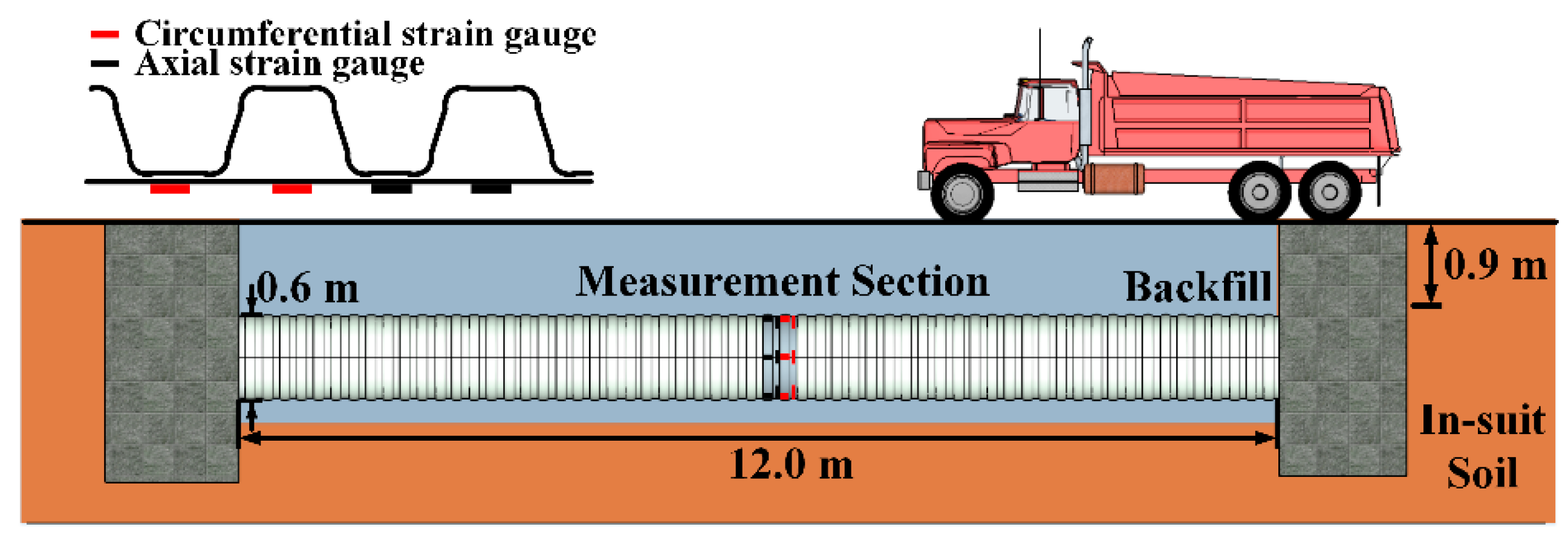

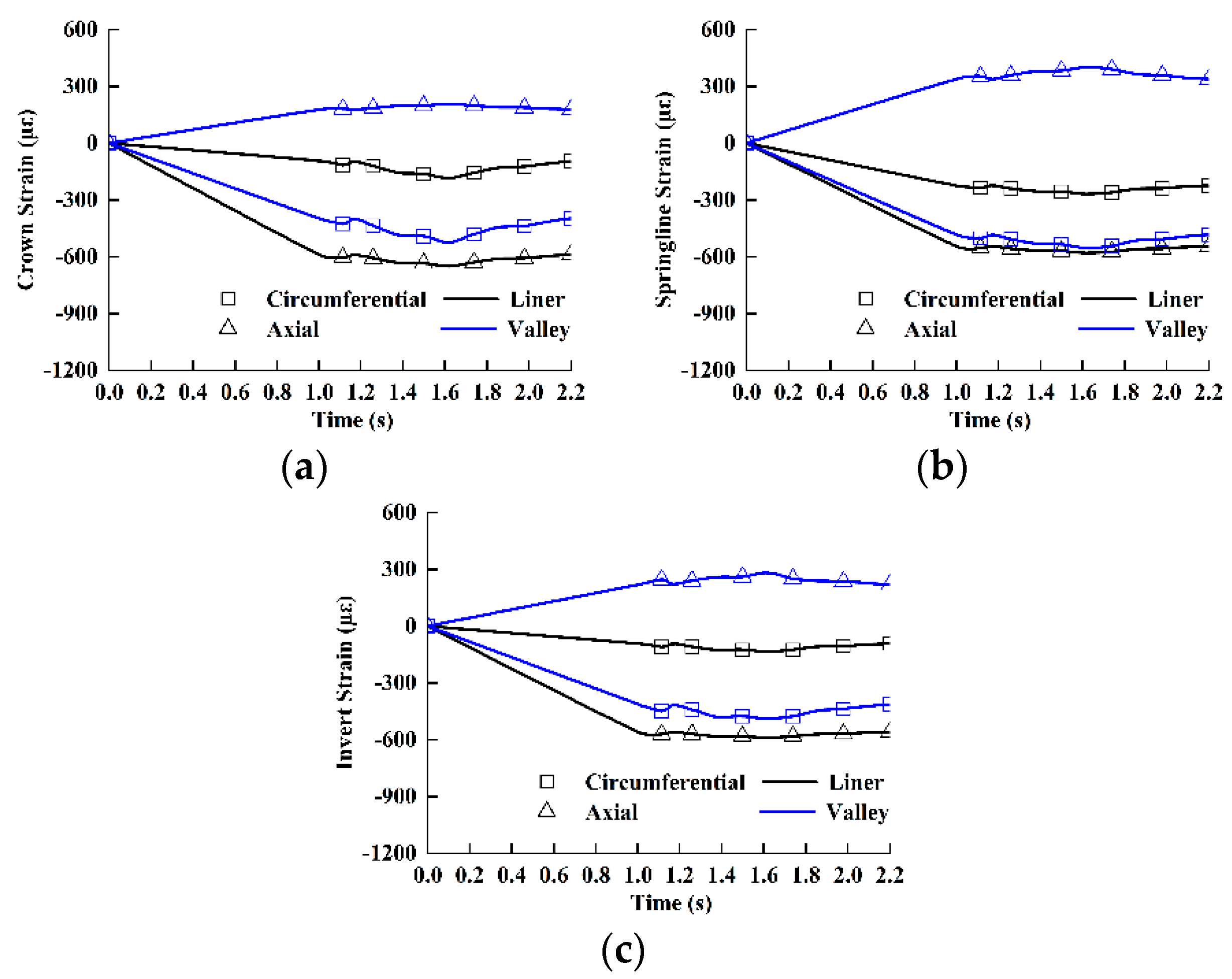
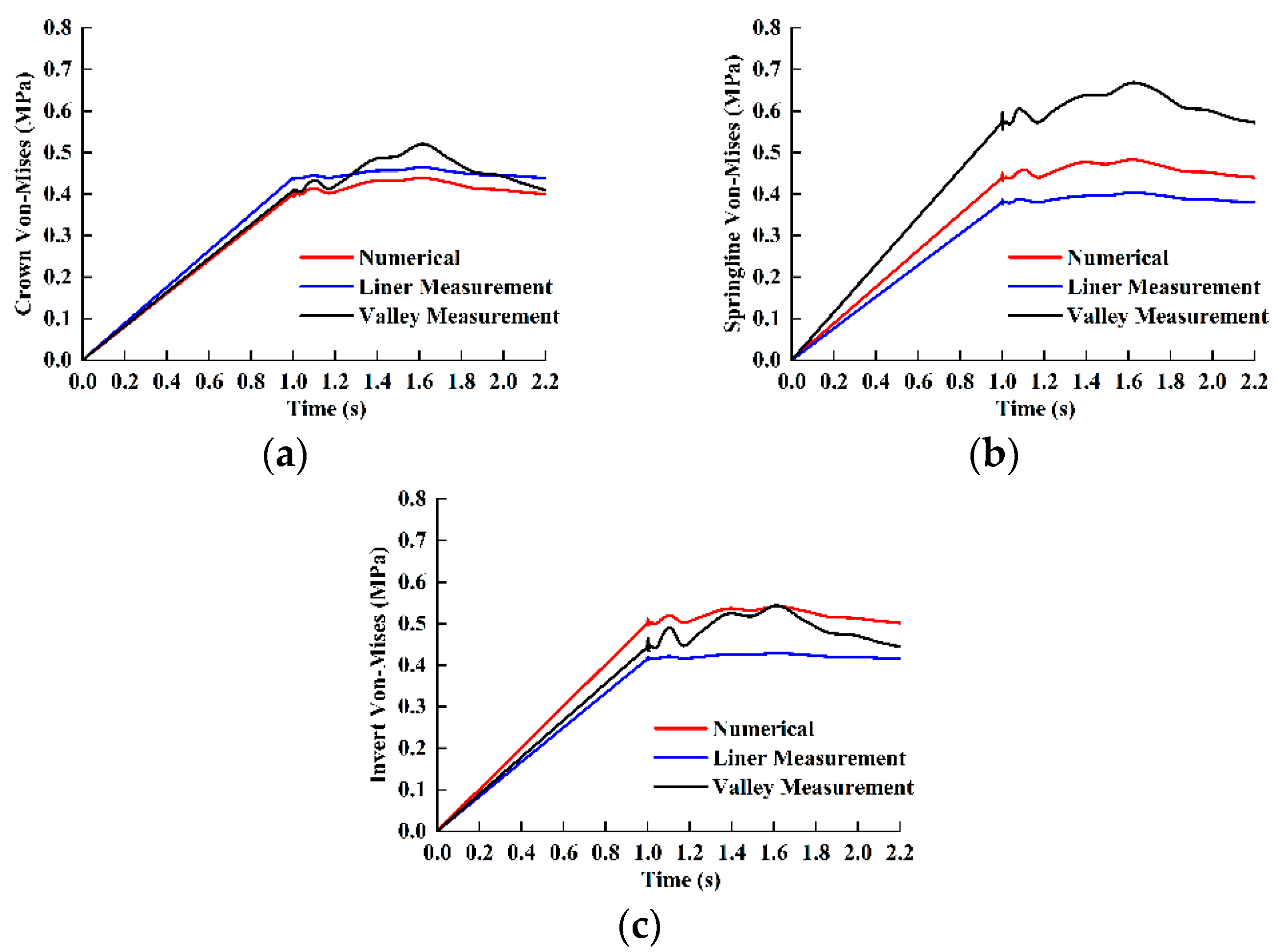
| Hoop Stiffness (kN/m2) | Nominal Diameter (mm) | Wall Thickness (mm) |
|---|---|---|
| 4 | 400 | 15.7 |
| 4 | 600 | 24.0 |
| 4 | 800 | 31.3 |
| 8 | 600 | 29.6 |
| 10 | 600 | 31.9 |
| Degree (kg/m3) | Elastic Modulus (MPa) | Poisson’s Ratio | |
|---|---|---|---|
| HDPE pipe | 950 | 800 | 0.4 |
| Pavement Layer | Density (kg/m3) | Elastic Modulus (MPa) | Poisson’s Ratio | Thickness (m) |
|---|---|---|---|---|
| AC-20 | 1200 | 2400 | 0.35 | 0.2 |
| ATB-30 | 1000 | 2400 | 0.30 | 0.4 |
| CTB | 1500 | 2300 | 0.20 | 0.2 |
| Backfill Layer | Dry Density (kg/m3) | Compaction Degree (%) | Elastic Modulus (MPa) | Angle of Internal Friction (°) | Cohesion (kPa) | Poisson’s Ratio |
|---|---|---|---|---|---|---|
| L1 | 1650 | 90 | 5 | 35 | 15 | 0.25 |
| L2 | 1650 | 95 | 7 | 26 | 10 | 0.25 |
| L3 | 1650 | 95 | 7 | 26 | 10 | 0.30 |
| L4 | 1650 | 85 | 3 | 26 | 18 | 0.30 |
| L5 | 1650 | 90 | 5 | 35 | 15 | 0.30 |
| L6 | 1650 | 90 | 5 | 35 | 15 | 0.30 |
| In-situ soil | 2020 | - | 30 | 28 | 20 | 0.30 |
| Backfill Material | Elastic Modulus E (MPa) | |||
|---|---|---|---|---|
| Compaction Degree (%) | ||||
| 85 | 90 | 95 | 100 | |
| Gravel | 5 | 7 | 10 | 20 |
| Gravel, sand pebbles, and fine-grained soil content less than 12% | 3 | 5 | 7 | 14 |
| Gravel, sand pebbles, and fine-grained soil content greater than 12% | 1 | 3 | 5 | 10 |
| Clay, silt, and sand content greater than 25% | 1 | 3 | 5 | 10 |
| Clay, silt, and sand content less than 25% | — | 1 | 3 | 7 |
| Backfill Condition * | Elastic modulus (MPa) | |||||
|---|---|---|---|---|---|---|
| Lay 01 | Lay 02 | Lay 03 | Lay 04 | Lay 05 | Lay 06 | |
| Standard | 5 | 7 | 7 | 3 | 5 | 5 |
| L1-loose | 1 | 7 | 7 | 3 | 5 | 5 |
| L1-85% | 3 | 7 | 7 | 3 | 5 | 5 |
| L2-loose | 5 | 1 | 7 | 3 | 5 | 5 |
| L2-85% | 5 | 3 | 7 | 3 | 5 | 5 |
| L3-loose | 5 | 7 | 1 | 3 | 5 | 5 |
| L3-85% | 5 | 7 | 3 | 3 | 5 | 5 |
| Load Magnitude (MPa) | Speed (km/h) | Diameter (mm) | Hoop Stiffness (kPa) |
|---|---|---|---|
| 0.5 | 60 | 600 | 4 |
| 0.7 | |||
| 1 | |||
| 0.7 | 30 | 600 | 4 |
| 40 | |||
| 50 | |||
| 0.7 | 60 | 400 | 4 |
| 800 | |||
| 0.7 | 60 | 600 | 8 |
| 10 |
| Properties | Value |
|---|---|
| Existing soil | |
| Maximum dry density (kg/m3) | 1549 |
| Water content (%) | 12 |
| Liquid limit (%) | 25.9 |
| Plastic limit (%) | 17.3 |
| Void ratio | 42.3 |
| Backfill sand | |
| Maximum dry density (kg/m3) | 1730 |
| Coarse sand (0.5–3 mm) (%) | 35 |
| Medium sand (0.35–0.5 mm) (%) | 57 |
| Fine Sand (0.25–0.35 mm) (%) | 8 |
| Grade | 120 |
© 2020 by the authors. Licensee MDPI, Basel, Switzerland. This article is an open access article distributed under the terms and conditions of the Creative Commons Attribution (CC BY) license (http://creativecommons.org/licenses/by/4.0/).
Share and Cite
Fang, H.; Tan, P.; Du, X.; Li, B.; Yang, K.; Zhang, Y. Numerical and Experimental Investigation of the Effect of Traffic Load on the Mechanical Characteristics of HDPE Double-Wall Corrugated Pipe. Appl. Sci. 2020, 10, 627. https://doi.org/10.3390/app10020627
Fang H, Tan P, Du X, Li B, Yang K, Zhang Y. Numerical and Experimental Investigation of the Effect of Traffic Load on the Mechanical Characteristics of HDPE Double-Wall Corrugated Pipe. Applied Sciences. 2020; 10(2):627. https://doi.org/10.3390/app10020627
Chicago/Turabian StyleFang, Hongyuan, Peiling Tan, Xueming Du, Bin Li, Kangjian Yang, and Yunhui Zhang. 2020. "Numerical and Experimental Investigation of the Effect of Traffic Load on the Mechanical Characteristics of HDPE Double-Wall Corrugated Pipe" Applied Sciences 10, no. 2: 627. https://doi.org/10.3390/app10020627
APA StyleFang, H., Tan, P., Du, X., Li, B., Yang, K., & Zhang, Y. (2020). Numerical and Experimental Investigation of the Effect of Traffic Load on the Mechanical Characteristics of HDPE Double-Wall Corrugated Pipe. Applied Sciences, 10(2), 627. https://doi.org/10.3390/app10020627






